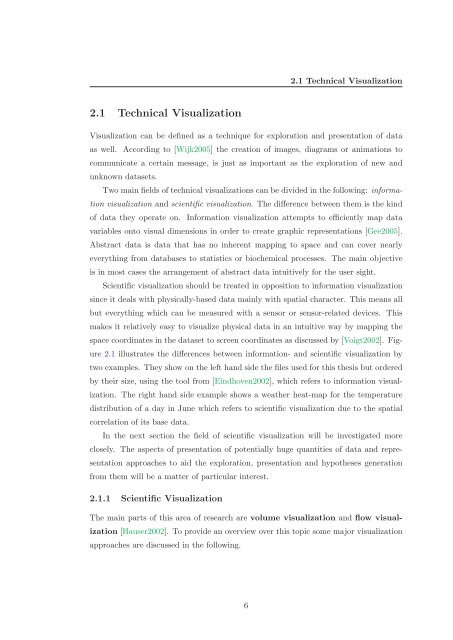Master's Thesis - Studierstube Augmented Reality Project - Graz ...
Master's Thesis - Studierstube Augmented Reality Project - Graz ...
Master's Thesis - Studierstube Augmented Reality Project - Graz ...
You also want an ePaper? Increase the reach of your titles
YUMPU automatically turns print PDFs into web optimized ePapers that Google loves.
2.1 Technical Visualization<br />
2.1 Technical Visualization<br />
Visualization can be defined as a technique for exploration and presentation of data<br />
as well. According to [Wijk2005] the creation of images, diagrams or animations to<br />
communicate a certain message, is just as important as the exploration of new and<br />
unknown datasets.<br />
Two main fields of technical visualizations can be divided in the following: information<br />
visualization and scientific visualization. The difference between them is the kind<br />
of data they operate on. Information visualization attempts to efficiently map data<br />
variables onto visual dimensions in order to create graphic representations [Gee2005].<br />
Abstract data is data that has no inherent mapping to space and can cover nearly<br />
everything from databases to statistics or biochemical processes. The main objective<br />
is in most cases the arrangement of abstract data intuitively for the user sight.<br />
Scientific visualization should be treated in opposition to information visualization<br />
since it deals with physically-based data mainly with spatial character. This means all<br />
but everything which can be measured with a sensor or sensor-related devices. This<br />
makes it relatively easy to visualize physical data in an intuitive way by mapping the<br />
space coordinates in the dataset to screen coordinates as discussed by [Voigt2002]. Figure<br />
2.1 illustrates the differences between information- and scientific visualization by<br />
two examples. They show on the left hand side the files used for this thesis but ordered<br />
by their size, using the tool from [Eindhoven2002], which refers to information visualization.<br />
The right hand side example shows a weather heat-map for the temperature<br />
distribution of a day in June which refers to scientific visualization due to the spatial<br />
correlation of its base data.<br />
In the next section the field of scientific visualization will be investigated more<br />
closely. The aspects of presentation of potentially huge quantities of data and representation<br />
approaches to aid the exploration, presentation and hypotheses generation<br />
from them will be a matter of particular interest.<br />
2.1.1 Scientific Visualization<br />
The main parts of this area of research are volume visualization and flow visualization<br />
[Hauser2002]. To provide an overview over this topic some major visualization<br />
approaches are discussed in the following.<br />
6





